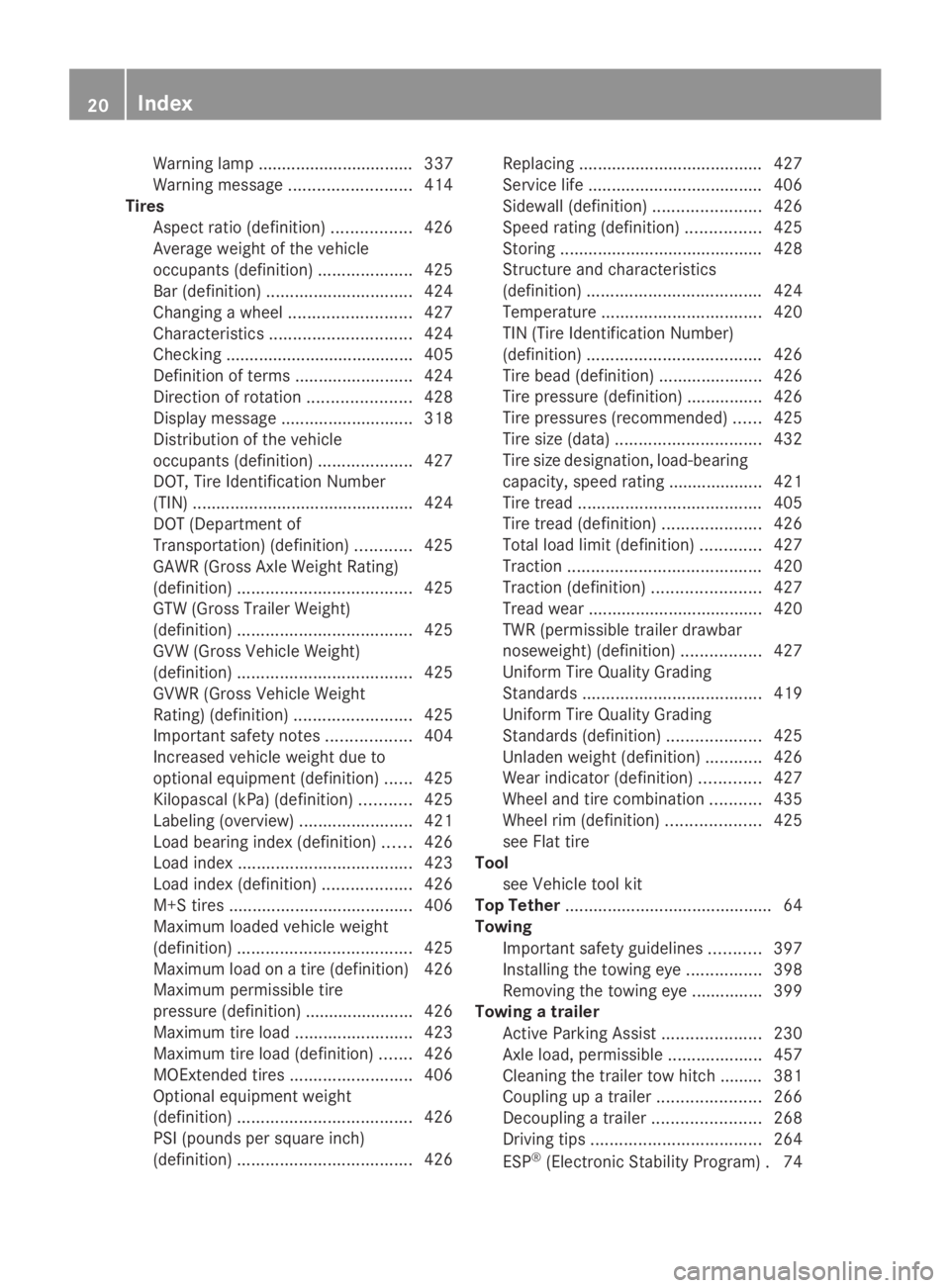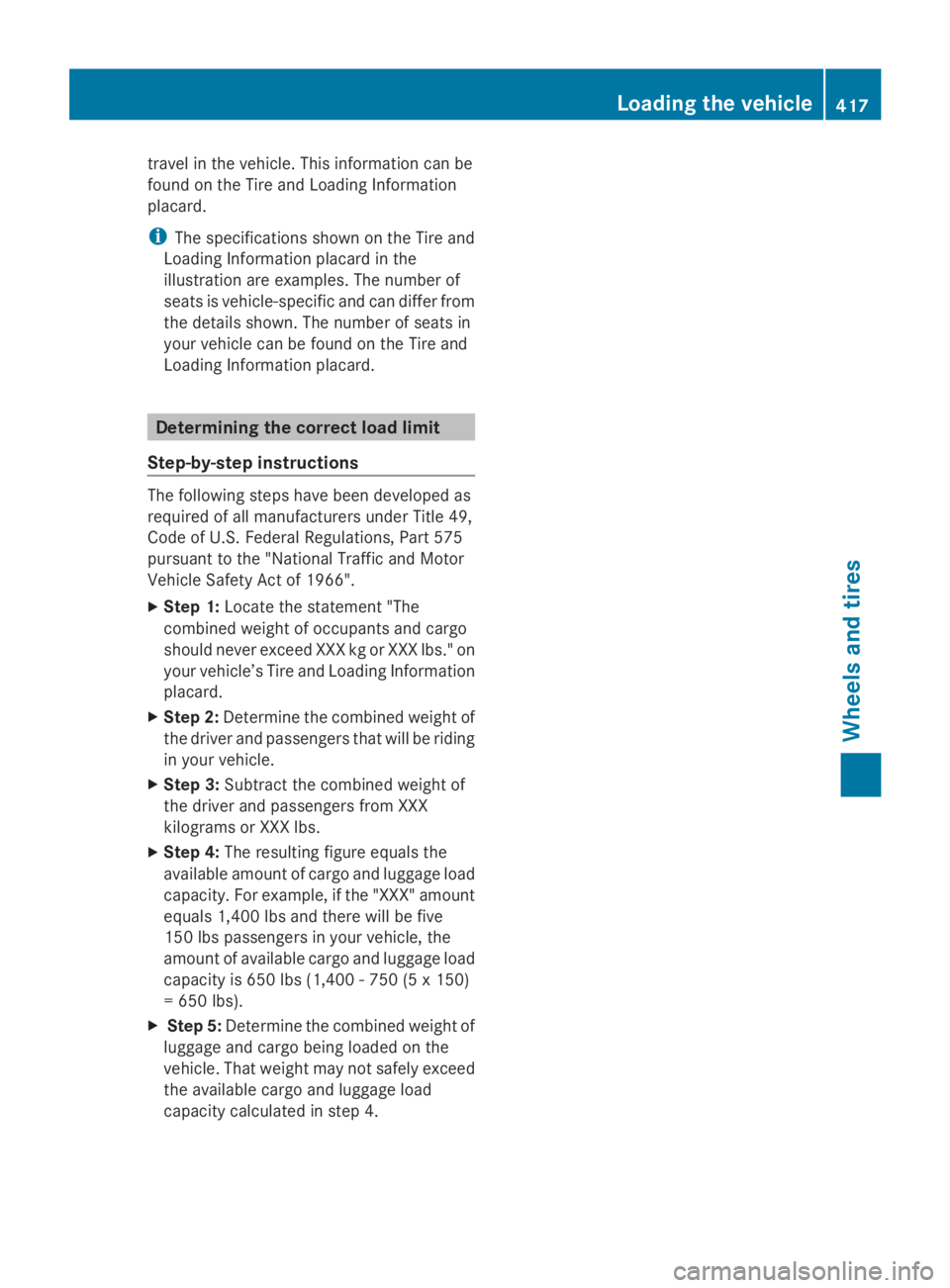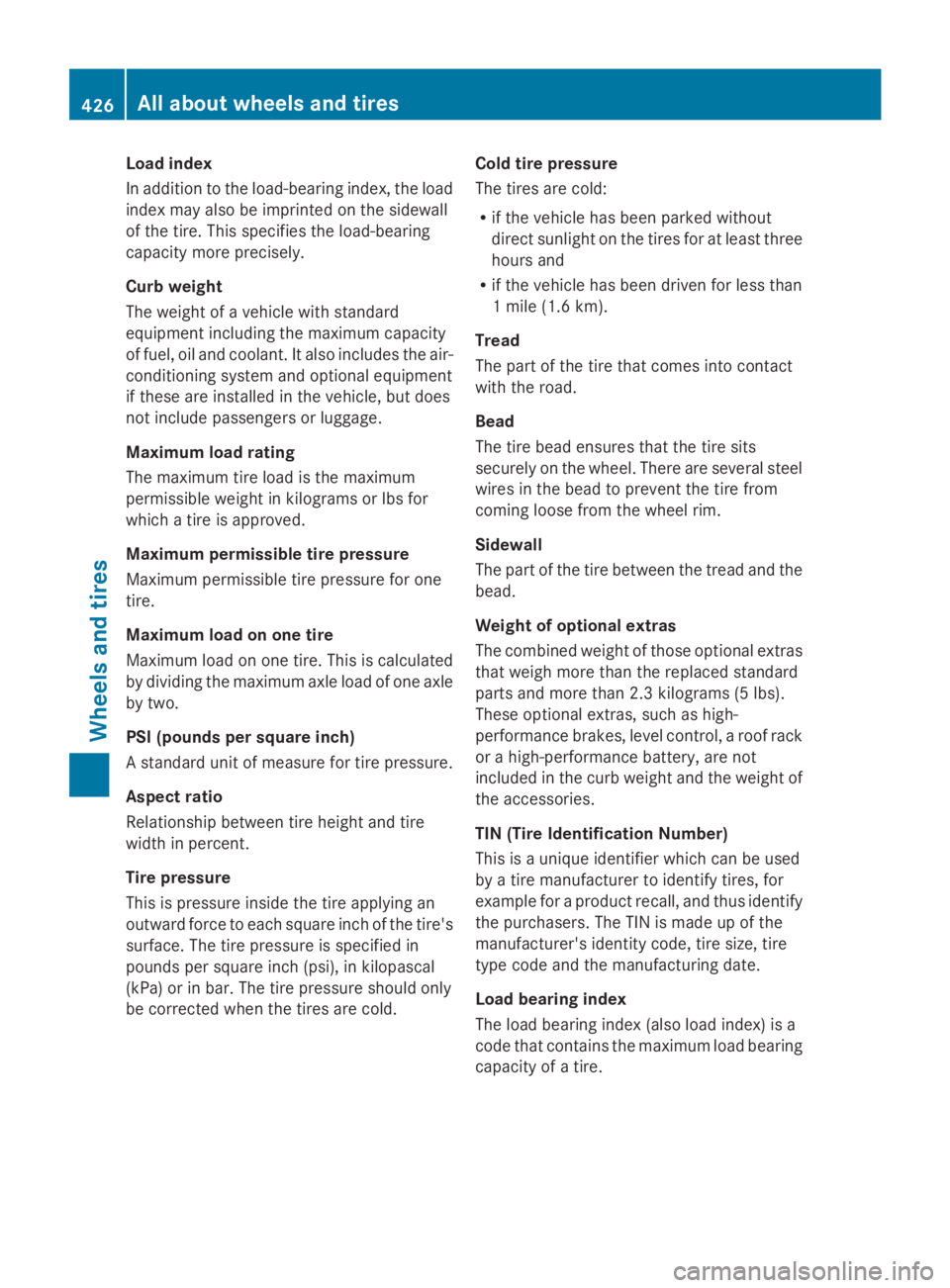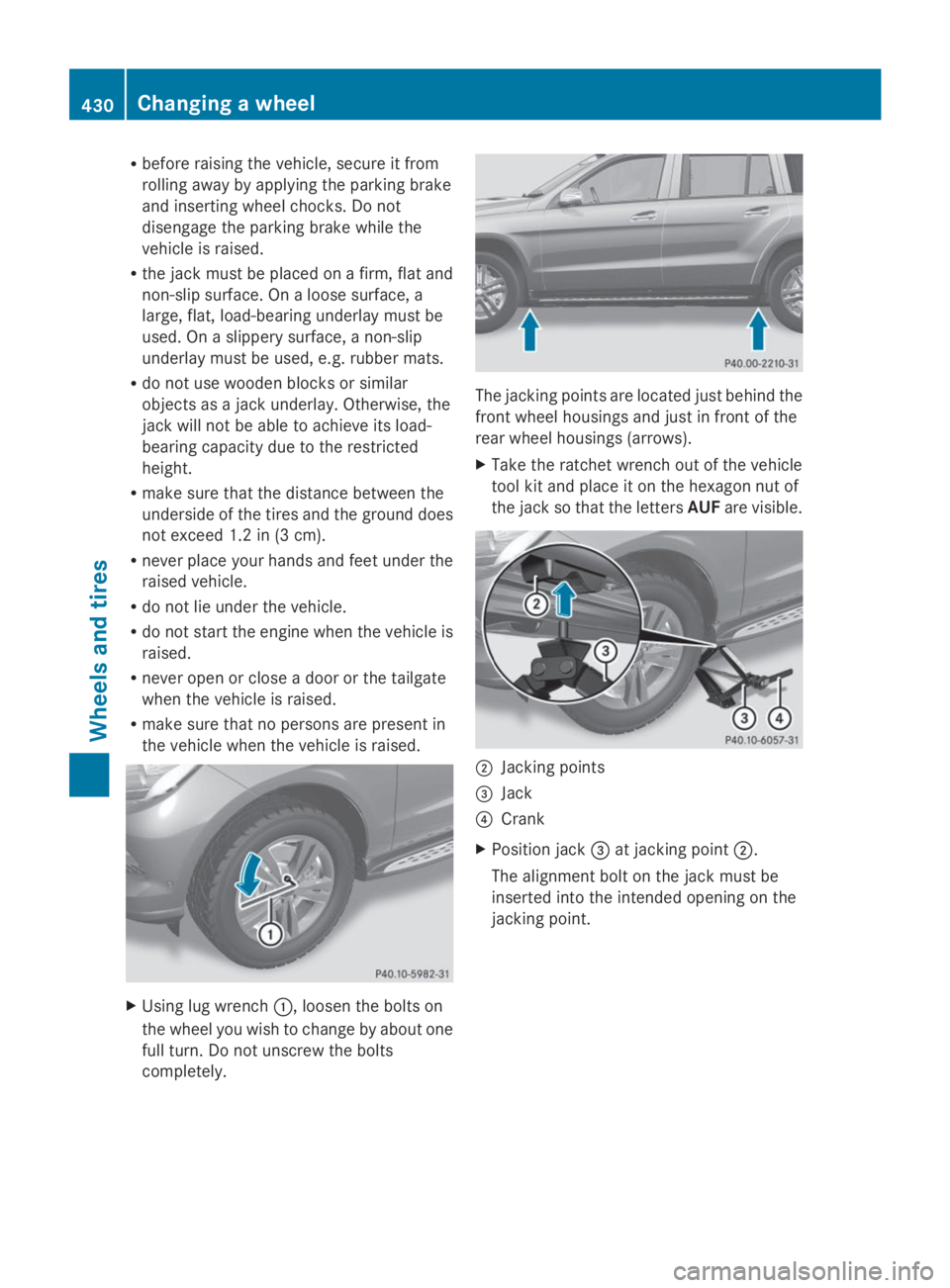load capacity MERCEDES-BENZ GL 2014 Owners Manual
[x] Cancel search | Manufacturer: MERCEDES-BENZ, Model Year: 2014, Model line: GL, Model: MERCEDES-BENZ GL 2014Pages: 462, PDF Size: 8.98 MB
Page 22 of 462

Warning lamp ................................. 337
Warning message..........................414
Tires
Aspect ratio (definition).................426
Average weight of the vehicle
occupants (definition)....................425
Bar (definition)...............................424
Changing a wheel..........................427
Characteristics..............................424
Checking ........................................ 405
Definition of terms.........................424
Direction of rotation......................428
Display message............................318
Distribution of the vehicle
occupants (definition)....................427
DOT, Tire Identification Number
(TIN) ...............................................424
DOT (Department of
Transportation) (definition)............425
GAWR (Gross Axle Weight Rating)
(definition).....................................425
GTW (Gross Trailer Weight)
(definition).....................................425
GVW (Gross Vehicle Weight)
(definition).....................................425
GVWR (Gross Vehicle Weight
Rating) (definition).........................425
Important safety notes..................404
Increased vehicle weight due to
optional equipment (definition)......425
Kilopascal (kPa) (definition)...........425
Labeling (overview)........................421
Load bearing index (definition)......426
Load index.....................................423
Load index (definition)...................426
M+S tires.......................................406
Maximum loaded vehicle weight
(definition).....................................425
Maximum load on a tire (definition) 426
Maximum permissible tire
pressure (definition) ....................... 426
Maximum tire load.........................423
Maximum tire load (definition).......426
MOExtended tires..........................406
Optional equipment weight
(definition).....................................426
PSI (pounds per square inch)
(definition).....................................426
Replacing.......................................427
Service life.....................................406
Sidewall (definition).......................426
Speed rating (definition)................425
Storing...........................................428
Structure and characteristics
(definition).....................................424
Temperature..................................420
TIN (Tire Identification Number)
(definition).....................................426
Tire bead (definition)......................426
Tire pressure (definition)................426
Tire pressures (recommended)......425
Tire size (data)...............................432
Tire size designation, load-bearing
capacity, speed rating .................... 421
Tire tread.......................................405
Tire tread (definition).....................426
Total load limit (definition).............427
Traction.........................................420
Traction (definition).......................427
Tread wear.....................................420
TWR (permissible trailer drawbar
noseweight) (definition).................427
Uniform Tire Quality Grading
Standards......................................419
Uniform Tire Quality Grading
Standards (definition)....................425
Unladen weight (definition)............426
Wear indicator (definition).............427
Wheel and tire combination...........435
Wheel rim (definition)....................425
see Flat tire
Tool
see Vehicle tool kit
Top Tether............................................64
Towing
Important safety guidelines...........397
Installing the towing eye................398
Removing the towing eye...............399
Towing a trailer
Active Parking Assist.....................230
Axle load, permissible....................457
Cleaning the trailer tow hitch ......... 381
Coupling up a trailer......................266
Decoupling a trailer.......................268
Driving tips....................................264
ESP®(Electronic Stability Program).74
20Index
Page 419 of 462

travel in the vehicle. This information can be
found on the Tire and Loading Information
placard.
iThe specifications shown on the Tire and
Loading Information placard in the
illustration are examples. The number of
seats is vehicle-specific and can differ from
the details shown. The number of seats in
your vehicle can be found on the Tire and
Loading Information placard.
Determining the correct load limit
Step-by-step instructions
The following steps have been developed as
required of all manufacturers under Title 49,
Code of U.S. Federal Regulations, Part 575
pursuant to the "National Traffic and Motor
Vehicle Safety Act of 1966".
XStep 1:Locate the statement "The
combined weight of occupants and cargo
should never exceed XXX kg or XXX lbs." on
your vehicle’s Tire and Loading Information
placard.
XStep 2:Determine the combined weight of
the driver and passengers that will be riding
in your vehicle.
XStep 3:Subtract the combined weight of
the driver and passengers from XXX
kilograms or XXX lbs.
XStep 4:The resulting figure equals the
available amount of cargo and luggage load
capacity. For example, if the "XXX" amount
equals 1,400 lbs and there will be five
150 lbs passengers in your vehicle, the
amount of available cargo and luggage load
capacity is 650 lbs (1,400 - 750 (5 x 150)
= 650 lbs).
XStep 5:Determine the combined weight of
luggage and cargo being loaded on the
vehicle. That weight may not safely exceed
the available cargo and luggage load
capacity calculated in step 4.
Loading the vehicle417
Wheels and tires
Z
Page 428 of 462

Load index
In addition to the load-bearing index, the load
index may also be imprinted on the sidewall
of the tire. This specifies the load-bearing
capacity more precisely.
Curb weight
The weight of a vehicle with standard
equipment including the maximum capacity
of fuel, oil and coolant. It also includes the air-
conditioning system and optional equipment
if these are installed in the vehicle, but does
not include passengers or luggage.
Maximum load rating
The maximum tire load is the maximum
permissible weight in kilograms or lbs for
which a tire is approved.
Maximum permissible tire pressure
Maximum permissible tire pressure for one
tire.
Maximum load on one tire
Maximum load on one tire. This is calculated
by dividing the maximum axle load of one axle
by two.
PSI (pounds per square inch)
A standard unit of measure for tire pressure.
Aspect ratio
Relationship between tire height and tire
width in percent.
Tire pressure
This is pressure inside the tire applying an
outward force to each square inch of the tire's
surface. The tire pressure is specified in
pounds per square inch (psi), in kilopascal
(kPa) or in bar. The tire pressure should only
be corrected when the tires are cold.
Cold tire pressure
The tires are cold:
Rif the vehicle has been parked without
direct sunlight on the tires for at least three
hours and
Rif the vehicle has been driven for less than
1 mile (1.6 km).
Tread
The part of the tire that comes into contact
with the road.
Bead
The tire bead ensures that the tire sits
securely on the wheel. There are several steel
wires in the bead to prevent the tire from
coming loose from the wheel rim.
Sidewall
The part of the tire between the tread and the
bead.
Weight of optional extras
The combined weight of those optional extras
that weigh more than the replaced standard
parts and more than 2.3 kilograms (5 lbs).
These optional extras, such as high-
performance brakes, level control, a roof rack
or a high-performance battery, are not
included in the curb weight and the weight of
the accessories.
TIN (Tire Identification Number)
This is a unique identifier which can be used
by a tire manufacturer to identify tires, for
example for a product recall, and thus identify
the purchasers. The TIN is made up of the
manufacturer's identity code, tire size, tire
type code and the manufacturing date.
Load bearing index
The load bearing index (also load index) is a
code that contains the maximum load bearing
capacity of a tire.
426All about wheels and tires
Wheels and tires
Page 432 of 462

Rbefore raising the vehicle, secure it from
rolling away by applying the parking brake
and inserting wheel chocks. Do not
disengage the parking brake while the
vehicle is raised.
Rthe jack must be placed on a firm, flat and
non-slip surface. On a loose surface, a
large, flat, load-bearing underlay must be
used. On a slippery surface, a non-slip
underlay must be used, e.g. rubber mats.
Rdo not use wooden blocks or similar
objects as a jack underlay. Otherwise, the
jack will not be able to achieve its load-
bearing capacity due to the restricted
height.
Rmake sure that the distance between the
underside of the tires and the ground does
not exceed 1.2 in (3 cm).
Rnever place your hands and feet under the
raised vehicle.
Rdo not lie under the vehicle.
Rdo not start the engine when the vehicle is
raised.
Rnever open or close a door or the tailgate
when the vehicle is raised.
Rmake sure that no persons are present in
the vehicle when the vehicle is raised.
XUsing lug wrench�C, loosen the bolts on
the wheel you wish to change by about one
full turn. Do not unscrew the bolts
completely.
The jacking points are located just behind the
front wheel housings and just in front of the
rear wheel housings (arrows).
XTake the ratchet wrench out of the vehicle
tool kit and place it on the hexagon nut of
the jack so that the lettersAUFare visible.
�DJacking points
�